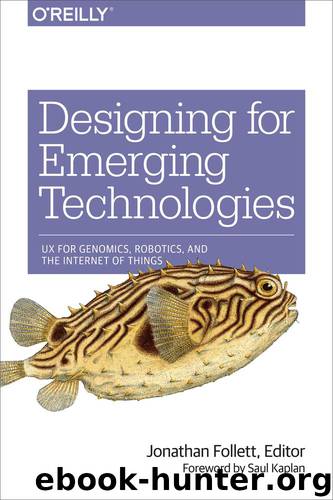Designing for Emerging Technologies: UX for Genomics, Robotics, and the Internet of Things by Follett Jonathan

Author:Follett, Jonathan
Language: eng
Format: epub, azw3
Tags: COMPUTERS / User Interfaces
ISBN: 9781449370640
Publisher: O'Reilly Media
Published: 2014-11-06T16:00:00+00:00
Designing for Software Instruments: from Gestures, through Mapping, to Sound
When designing a software-based musical instrument, either from scratch or by extending a familiar instrument, choosing its inputs and outputs is relatively easy. The instrument’s inputs are buttons, knobs, tilt sensors, cameras, or even whichever of these is found in a smartphone. Its outputs might just be dictated by what commands can be sent to the instument’s audio synthesizer, be that a chip or software. Common outputs are pitch (how high a sound is) and loudness. Other aspects of timbre can come from a set of discrete presets, such as the trumpet and harpsichord buttons on a department store keyboard.
At this point, after choosing inputs and outputs, the real work of XD begins. To see what a difference is made by the input-to-output mapping, let’s consider three real-world examples that use the same gesture-inputs and sound-outputs, varying only the mapping.
Conventional pickup-and-amplifier instrument, such as an electric guitar or electric violin, plus a tilt sensor. (Duct-tape a smartphone to the instrument.) Feed the pickup and the tilt sensor into a computer (perhaps that same smartphone), which computes sound to send to the amplifier.
Inputs: tilt, pitch, and loudness.
Outputs: pitch and loudness.
Unless otherwise specified, pitch maps to pitch, and loudness to loudness.Rock star
High notes are dramatic in everything from Van Halen to Wagner. To make them easier to play while maintaining drama, when the instrument points up, raise the output pitch by an octave or two.
Download
Designing for Emerging Technologies: UX for Genomics, Robotics, and the Internet of Things by Follett Jonathan.azw3
This site does not store any files on its server. We only index and link to content provided by other sites. Please contact the content providers to delete copyright contents if any and email us, we'll remove relevant links or contents immediately.
The Mikado Method by Ola Ellnestam Daniel Brolund(11864)
Hello! Python by Anthony Briggs(11788)
Dependency Injection in .NET by Mark Seemann(10999)
The Well-Grounded Java Developer by Benjamin J. Evans Martijn Verburg(9420)
Sass and Compass in Action by Wynn Netherland Nathan Weizenbaum Chris Eppstein Brandon Mathis(8808)
Secrets of the JavaScript Ninja by John Resig Bear Bibeault(8594)
Svelte with Test-Driven Development by Daniel Irvine(8061)
Test-Driven Development with PHP 8 by Rainier Sarabia(7818)
Layered Design for Ruby on Rails Applications by Dementyev Vladimir;(7632)
Secrets of the JavaScript Ninja by John Resig & Bear Bibeault(7407)
Kotlin in Action by Dmitry Jemerov(7262)
Web Development with Django by Ben Shaw Saurabh Badhwar(7128)
React Application Architecture for Production by Alan Alickovic(6822)
Jquery UI in Action : Master the concepts Of Jquery UI: A Step By Step Approach by ANMOL GOYAL(6445)
Software Architecture for Web Developers by Mihaela Roxana Ghidersa(4933)
Audition by Ryu Murakami(4840)
Accelerating Server-Side Development with Fastify by Manuel Spigolon Maksim Sinik & Matteo Collina(4799)
Solidity Programming Essentials by Ritesh Modi(4517)
Hands-On Full-Stack Web Development with GraphQL and React by Sebastian Grebe(4410)
